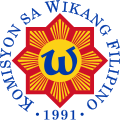
Back Komisyon sa Wikang Filipino AST Komisyon sa Wikang Filipino BCL Komisyon sa Wikang Filipino CEB Comisión de la Lengua Filipina Spanish Komisyon sa Wikang Filipino ID Komision iti Pagsasao a Filipino ILO Komisyon sa Wikang Filipino Tagalog
| Filipino: Komisyon sa Wikang Filipino | |
 | |
 Facade of official headquarters | |
| Agency overview | |
|---|---|
| Formed | November 13, 1936[1] (first formation) August 14, 1991[2] (present form) |
| Jurisdiction | Government of the Philippines |
| Headquarters | San Miguel, Manila, Philippines 14°35′55″N 120°59′51″E / 14.59873°N 120.99753°E |
| Annual budget | ₱107.53 million (2018)[3] |
| Agency executives |
|
| Parent department | Office of the President |
| Key documents | |
| Website | kwf |


The Commission on the Filipino Language (CFL),[2] also referred to as the Komisyon sa Wikang Filipino (KWF),[a] is the official regulating body of the Filipino language and the official government institution tasked with developing, preserving, and promoting the various local Philippine languages.[4][5] The commission was established in accordance with the 1987 Constitution of the Philippines.
Established by Republic Act No. 7104 in 1991,[2] the commission is a replacement for the Institute of Philippine Languages (IPL; Linangan ng mga Wika sa Pilipinas) that was set up in 1987 which was a replacement of the older Institute of National Language (INL; Surian ng Wikang Pambansa), established in 1937 as the first government agency to foster the development of a Philippine national language.[6]
- ^ Cite error: The named reference
GovPH-CA184was invoked but never defined (see the help page). - ^ a b c Cite error: The named reference
RA7104was invoked but never defined (see the help page). - ^ "Other executive offices" (PDF). www.dbm.gov.ph. December 29, 2017. Retrieved February 24, 2020.
- ^ "Wika / Misyon at Bisyon". wika.pbworks.com.
- ^ Gonzalez, Andrew (1988). "The Language Planning Situation in the Philippines" (PDF). Journal of Multilingual and Multicultural Development. 19 (5&6). multilingual-matters.net: 508. eISSN 1747-7557. ISSN 0143-4632. Archived from the original (PDF) on June 16, 2007.
The Commission was charged with the mission not only to develop Filipino as a language of literature and as an academic language but likewise to preserve and develop the other languages.
- ^ Catacataca, Pamfilo. "The Commission on the Filipino Language". Archived from the original on March 6, 2012. Retrieved June 24, 2010.
Cite error: There are <ref group=lower-alpha> tags or {{efn}} templates on this page, but the references will not show without a {{reflist|group=lower-alpha}} template or {{notelist}} template (see the help page).